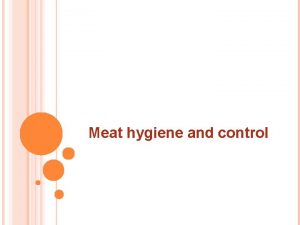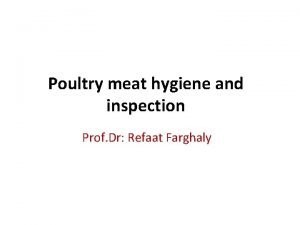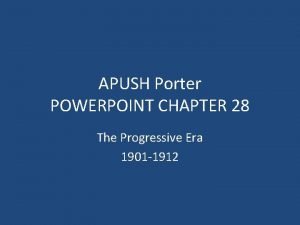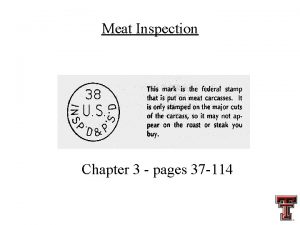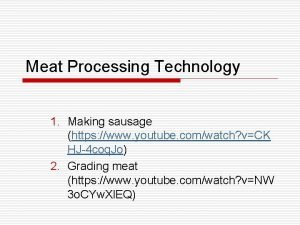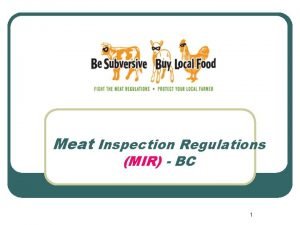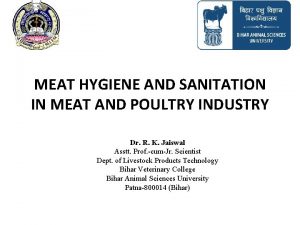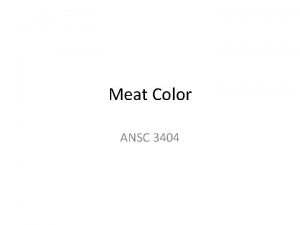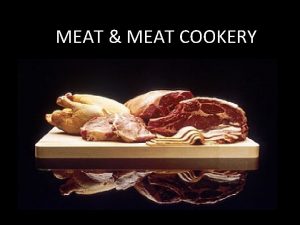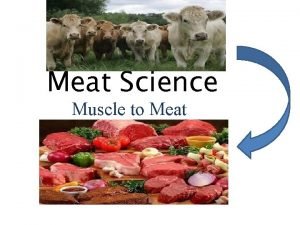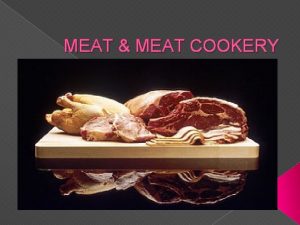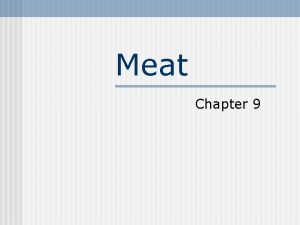MEAT HYGIENE INSPECTION TECHNOLOGY What is meat The















- Slides: 15

MEAT HYGIENE, INSPECTION & TECHNOLOGY

What is meat? • The flesh(muscle) of animals used as food. • Include, as well as the musculature, organs such as liver and kidney, brains and other edible tissues.


Non-domesticated sources of meat Horse Deer Dogs Cats Seal Polar bear Camel Crocodile Hippopotamus Elephant Kangoroo

Red meat Types of meat White meat Game meat

Meat in Human Diet • Good source of protein (concentrated and easily assimilable) • Stimulating the metabolism • Satisfaying- presence of fat • Palatable- gastric stimulant • Digestible

Meat Consumption

Nutritional Values • Concentrated source of protein which is not only of high biological value but its amino acid composition complements that of cereal and other vegetable proteins. • Good source of iron and zinc and several B vitamins, liver-vitamin A.

Carcass • The term carcass is used in meat industry and represent the portion of body left after removal of the blood, head, feet, hides, internal organs (digestive tract, intestine, bladder, heart, trachea, lungs, kidneys, spleen etc. ) and adhering fatty tissues.

Muscle Connective tissue Fat Bone Water Species Breed Size Age

Fat Calorie Cholesterol Iron

Proteins Myofibrillar proteins Sarcoplasmic proteins Stromal protein Muscle proteins can be broadly classified into three types depending on their solubility properties.

Sarcoplasmic proteins • These are readily extracted in aqueous solution of low ionic (0. 15 or less) strength • Soluble in water or very dilute salt solutions. • It constitutes about 5. 5 per cent of total muscle mass. • There about 50 sarcoplasmic proteins. myoglobin, hemoglobin, enzymes associated with glycolysis, the tricarboxylic acid cycle and the electron transport chain, flavour proteins.

Myofibrillar proteins • These are soluble in concentrated salt solutions and require higher (0. 3 or greater) ionic strength solutions of sodium or potassium salts for their extraction. • Since they are extracted by salt solutions, they are called salt-soluble proteins. • They constitute about 11. 5 per cent of muscle mass. • The myofibrillar proteins are further classified into three categories

Contractile proteins • Role in muscle cotntraction • Actin 20%, Myosin 45% Regulatory proteins • regulation of actin-myosin interaction during muscle contraction and in maintenance of myofibril integrity • Tropomyosin, troponin, a-actinin and p-actinin Cytoskeleton protein • Aligment and/or provide structural integrity of myofibrils • Titin, nebulin, C-protein, myomesin, M-protein, desmine, filamin, vinculin, synemin, 2 -protein, creatinine kinase
 Objectives of meat hygiene
Objectives of meat hygiene Poultry meat hygiene and inspection
Poultry meat hygiene and inspection Meat inspection act apush definition
Meat inspection act apush definition On package
On package Branch inspection technology
Branch inspection technology It is a market form of meat preserved by chemical process
It is a market form of meat preserved by chemical process Meat processing technology
Meat processing technology Một số thể thơ truyền thống
Một số thể thơ truyền thống Trời xanh đây là của chúng ta thể thơ
Trời xanh đây là của chúng ta thể thơ Các số nguyên tố là gì
Các số nguyên tố là gì Phối cảnh
Phối cảnh đặc điểm cơ thể của người tối cổ
đặc điểm cơ thể của người tối cổ Tỉ lệ cơ thể trẻ em
Tỉ lệ cơ thể trẻ em Các châu lục và đại dương trên thế giới
Các châu lục và đại dương trên thế giới Thế nào là hệ số cao nhất
Thế nào là hệ số cao nhất ưu thế lai là gì
ưu thế lai là gì
